Passing, digging, receiving, bumping.
Whatever you want to call the physical task of passing the volleyball, I think we can all agree it is without a doubt one of the most important skills in volleyball.
I have said many times across many different articles that nothing in volleyball can be achieved without first learning how to pass the volleyball.
Whether that be from receiving the ball from a tough serve, passing a free ball into the setter, digging the ball up from a hard driven attack or simply bumping the ball up for an attacker to swing on.
Now if you have landed on this article I am going to assume you already know the basics of passing a volleyball and you are looking for some drills that can take your passing game to the next level.
This article is going to list some of the top passing drills for advanced players, you can use these drills at your next practice to get your team passing dimes all the time.
The best advanced passing drills in volleyball are as follows:
- Vollice warmup
- Two-Way Pepper
- Butterfly Drill
- Serve Receive Repetitions
- Corner Pits
- Touch Ten
- 3-2-1-0 Passing
- Attack vs Defense
Now a lot of these names probably don’t mean anything to you.
And to be completely honest I made a lot of them up, so good luck trying to guess as my mind works in mysterious ways at times.
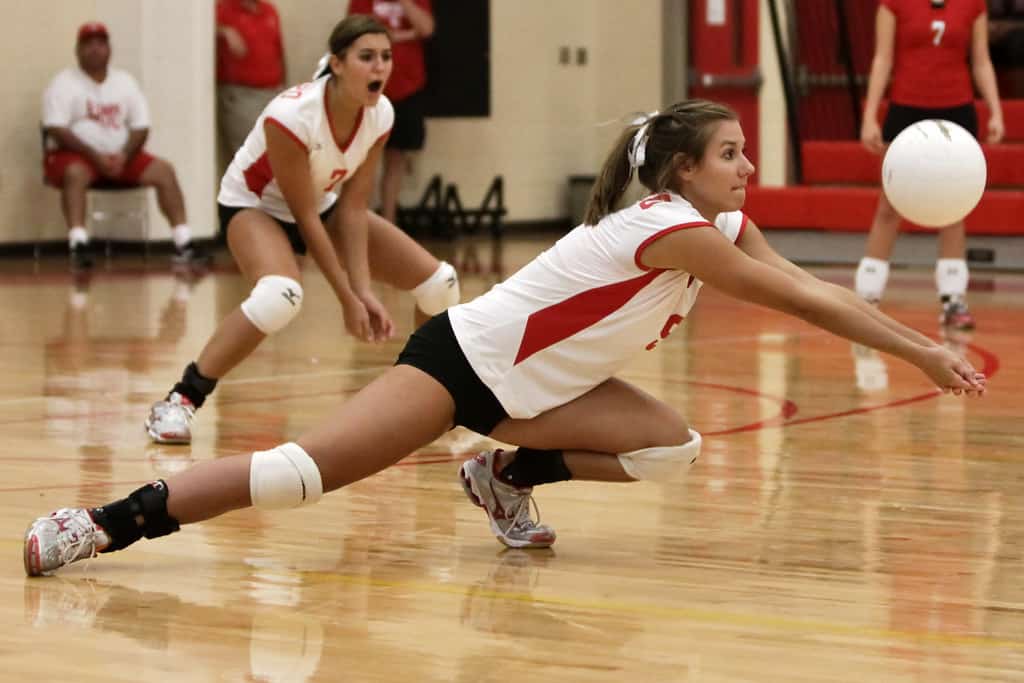
These drills are specifically designed to work on individual actions that are regularly taking place in Volleyball.
As always before carrying out any of these drills it is vital that you and your team are thoroughly warmed up prior to starting.
Table of Contents
Warm-up Passing Drills
After a traditional warmup such as running laps to get the blood moving and stretching out the usual muscle groups it is important to ready the ball for task specific movements such as passing the volleyball.
Now your previous warm up would have started this process anyway but these drills are a way to incorporate warming up with practicing skills and also a bit of enjoyment.
The first game is something that me and my team have always referred to as vollice.
Vollice
To be honest I am not even sure if that is the correct spelling so I have spelt it out as it would be pronounced.
Vollice is a game which requires the squad to be split up into two teams.
One team will line up behind one baseline and the other team will line up on the opposite end of the court.
The first person in the line will underarm serve to the team on the opposite side of the court.
The first playing from the receiving team will run to meet the serve and dig the ball back over the net, with the intention of trying to win the point by making it land in a spot that is too hard to reach or alternatively too hard to return.
The game of vollice is played very similarly to traditional volleyball in the sense that a point is won by making the ball land in the court on the opposition’s side or by causing the opposition to make an error.
The difference however, is that each team is allowed only 1 touch before the ball must be returned and this must be an underarm dig (No tomahawks or similar are allowed).
The aim of this drill is to not only get the players moving but it also encourages players to think about their footwork to ensure they can dig the ball properly whilst putting the ball into touch to reach areas on the opposite side.
This game is great to get players warm whilst conditioning the team to give no easy free balls to the opponents.
Two-Way Pepper
After Vollice the team should all be very warm and be in the right mindset to pass, receive the ball.
The pepper is another staple component to nearly all warmups, however, for experienced players the simple act of dig, set, spike to each other becomes rather comfortable and almost section nature.
This is where the two-way pepper comes into play.
The Two-Way Pepper requires the squad to be split into teams of 4 and preferably spaced out evenly with two players one side of the net and the other two on the opposite side of the net.
Each 4 will have 2no. Balls between them with the balls both starting on the same side of the net.
The two players with the balls will tap the balls to start the drill and then play a downball to the player standing over the net directly in front of them.
The two receiving players will pass to themselves, set themselves and then play a downball diagonally across the court.
The ball is now on the side of the two players that originally started the drill, these players must again pass to themselves, set themselves and hit a down ball again to the player standing over the net directly in front of them.
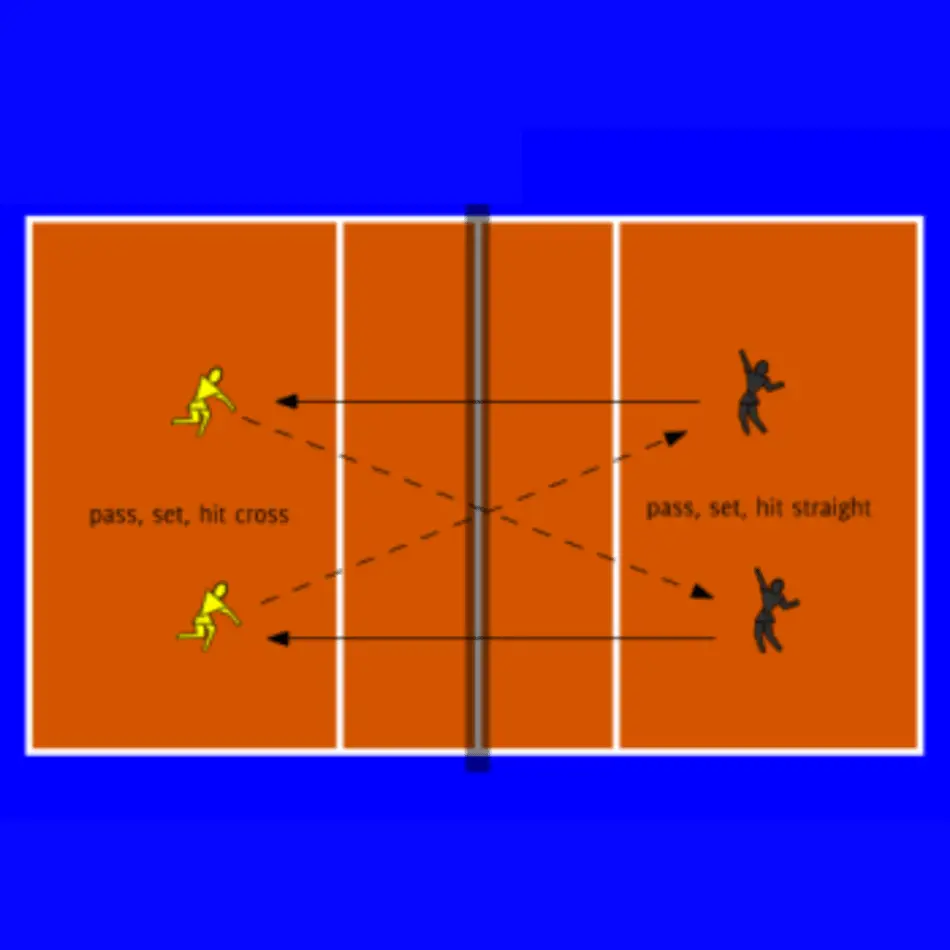
The pattern will be repeated several times before the drill is stopped and the players previously hitting cross court will start the drill to allow the other players to receive and hit cross court.
If the drill is too easy we can really up the difficulty factor by removing a few steps.
When the drill is started rather than the receiving players, passing to themselves, setting themselves etc..
We can actually skip a few steps and have the receivers instantly pass the ball diagonally back over the net for the two players who started the drill to instantly return a down ball directly in front of them again.
This is a fantastic drill to train players to pass the ball and focus instantly on being ready to receive again, rather than playing a pass and standing up to admire how good it was.
It can also be a fantastic drill for getting lots of repetitions in whilst passing both left and right.
Butterfly Drill
The butterfly drill is similar to a traditional side out drill in which one player serves while the receivers pass the ball in and spike the ball.
The difference with the butterfly drill is that it is restricted to half court whilst the drill is mirrored on the other half of the court.
What I mean by this is that on the right side of the court there will be one setter, two passers (With one of them being ready to hit after passing) and a server.
There will also be the same setup on the left side of the court.
To avoid a big cluster of players the two passers and setter on each side will be on opposite sides of the court and the serve will come in from opposite ends.
This drill is brilliant for helping players be confident in taking the ball in clustered passing lines rather than letting the other players around them step up and pass.
It also is great for passing accuracy as you are confined to just one half of the court.
The drill is started when both servers are in position at opposite ends of the court.
Both players will serve the ball to the two passers which on each side, one of the receivers will take the first pass and the player who doesn’t pass will get ready to hit the ball either through the middle or wing as required.
After the ball is spiked each player will move round one position with the exception of the setters.
This means the server will became a passer, one of the passes will move passing positions, the 2nd passer will move onto to serve on the opposite side.
The cycle continues for as many repetitions as required until teams are fully warmed up and passing at a good level of consistency.
Serve Receive Drills
Hopefully using the above 3 drills of combination thereof your team is extremely warmed up and ready to work on passing.
One of the biggest challenges in volleyball is serve receive, it is something that trumps nearly all teams and more often than not, the team that receives best goes on to win the game.
So with that being said serve receive is vitally important.
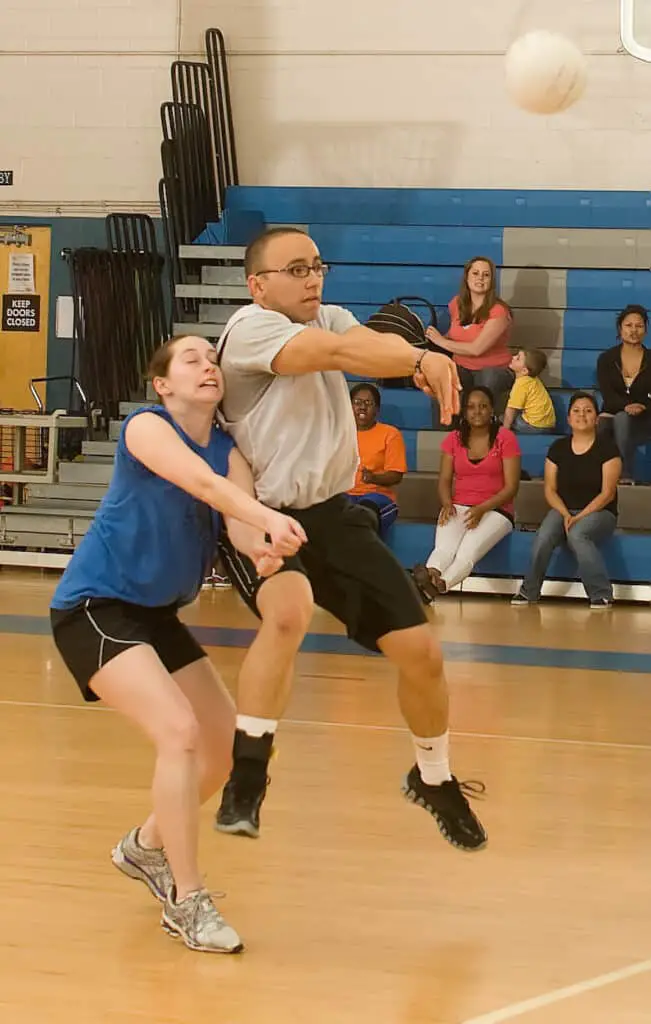
Serve Receive Repetitions
Unfortunately there really aren’t many glamorous drills to improve serve receive other than practicing serve receive.
The best way to get serve receive repetitions in, is by selecting three receivers from the squad and placing them down one end of the court and setting them up in a passing line.
You will also want to send one player down with the passers to stand in the setter position, don’t worry this player doesn’t have to set, they are merely representational and will act as a ball collector.
The remaining players will each grab a ball and lineup ready to serve.
The serving players will work on their game serves purposely trying to serve to get the ace or cause the error.
Make sure the servers go 100% as the opposition you next face won’t be serving anything less.
The servers will take turns practicing game serves whilst the 3 receivers focus on passing the ball into a setter.
The main aim of the drill is to get lots of repetitions in for the receivers, this drill is also great at helping passing lines decide in what circumstances each player will receive the ball.
There is nothing worse than a passing line who each leave the ball thinking the player next to them is passing when they aren’t.
The main coaching points for this drill are to ensure players are calling for the ball when they are passing to avoid confusion on who is passing and also to ensure that if the receivers make an error they shake it off and pass the next ball perfectly.
We are all humans and all mistakes, the important thing is not to repeat the mistake.
3-2-1-0 Drill
If you are referring to the above list you will notice that I have snuck this one in earlier than I had it listed.
The main reason for this is I was originally not going to include it in this section but I feel it would be very advantageous in this category so I can’t not include it.
The 3-2-1-0 drill is based on the passing scoring system nearly all teams use.
The 3,2,1,0 scoring system is a way of measuring how good or bad a pass was.
- 3 – Perfect Pass
- 2 – Good Pass
- 1 – Okay Pass
- 0 – Passing Error
Now you may be thinking how exactly you determine what is a perfect pass compared to a good pass.
Well the easiest way to think of this is how many options did the setter have.
For example if the pass is perfect they can set the middle, outside hitter or the opposite player. This means they had 3 hitting options
If the pass isn’t very good and the setter has to set the outside hitter they only have 1 setting option because of the pass.
Think of these numbers as how many options did the setter have available and they will become more obvious.
This is where we can use this scoring system to improve passing specifically during serve receive.
Using the same set up as the serve receive repetition drill, this being 3 receivers and 1 setter on one side with the rest of the squad serving we can use the scoring system to give players a visualization of what each score looks like.
The way in which we do this is by having the servers again use their match serves to challenge the passers, the receivers will pass the ball into the setter.
As the ball arrives at the setter, the setter will shout what score the pass gets based on how many options they feel they would have had available.
For example if the pass is perfect and the setter thinks they could have easily set forwards, short for the middle or reverse they would shout 3.
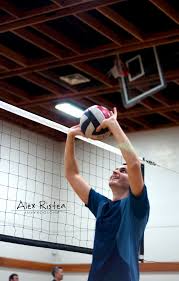
If the pass isn’t as good and the setter struggles to track down the ball they would shout 1.
The idea of the drill is to allow the receivers to visually see what a perfect pass looks like and what a shank looks like.
This drill is not to make the receivers feel bad about their passing but to try and get a more consistent reception and make the setters’ life easier.
Digging Drills
Now regardless of how good your team is you will inevitably face an attacking shot from the opposition, how good your team is at digging the ball will greatly impact your chances of saving that rally and ultimately winning the point.
Digging the ball requires a great amount of hustle and commitment as well as the ability to read the game.
There are a couple of great drills that will get your players moving, diving and reacting.
Corner Pits
Corner pits involves 1 defensive player, 1 hitter (preferably on a box or hop-up) and a square in each corner of the defensive’s side of the court.
The hitter will stand up on the box with a collection of balls at the ready.
The defensive player will start in the middle of the court with the 4 marked squares surrounding them.
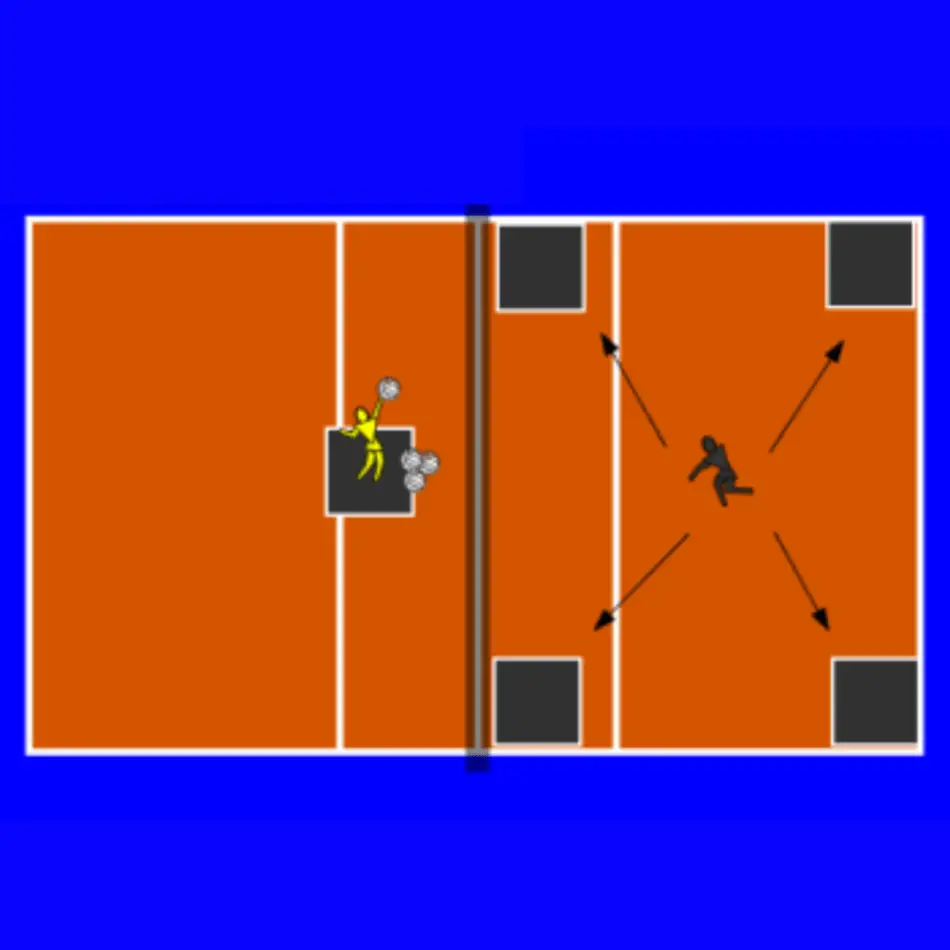
The player on the box will slap the ball to signify the start of the drill, they will then toss the ball up and hit/ tip the ball trying to make it land in one of the 4 squares.
The defenders job is to prevent the ball from hitting from the floor and more specifically making sure the ball doesn’t land in one of the squares.
The best way I have found to monitor the drill is to use a score system.
Each defender will have 10 balls to try and pick up.
If the defender digs the ball and manages to direct it towards a good setting position they will receive 2 points.
If the defender touches the ball before it hits the floor they will receive 1 point.
If the ball hits the floor within the lines but does not land in a square the defender will lose 1 point.
If the attacker plays the ball inside one of the squares and the defender doesn’t touch the ball the defender will lose 2 points.
Once every player has taken a turn about being the defender the player with the highest overall score wins.
This drill emphasises the importance of chasing down every ball and getting a touch even if the player is unable to get a good pass into the setter it teaches them to win 1 point rather than give up and lose 1, much like in real volleyball.
Touch Ten
Touch ten is a variation of the above noted game however it is much more simple in principle.
This game requires 1 defender and 1 feeder.
The feeder will be on one side of the court with a collection of balls and the defender will be on their toes ready on the opposite side.
The feeder will throw the balls onto the opposite side one after the other, the defenders job is to touch ten balls before they contact the ball.
To ensure this drill is as challenging as possible the feeder should mix up where the ball is thrown and how quickly after each ball is fed the next one is thrown in.
The drill continues until the defender successfully touches 10 balls.
This drill is great for teaching players the importance of hustling for each ball and also teaches them to play the ball and get ready for the next touch not to dwell on successful touches.
Free-ball Passing
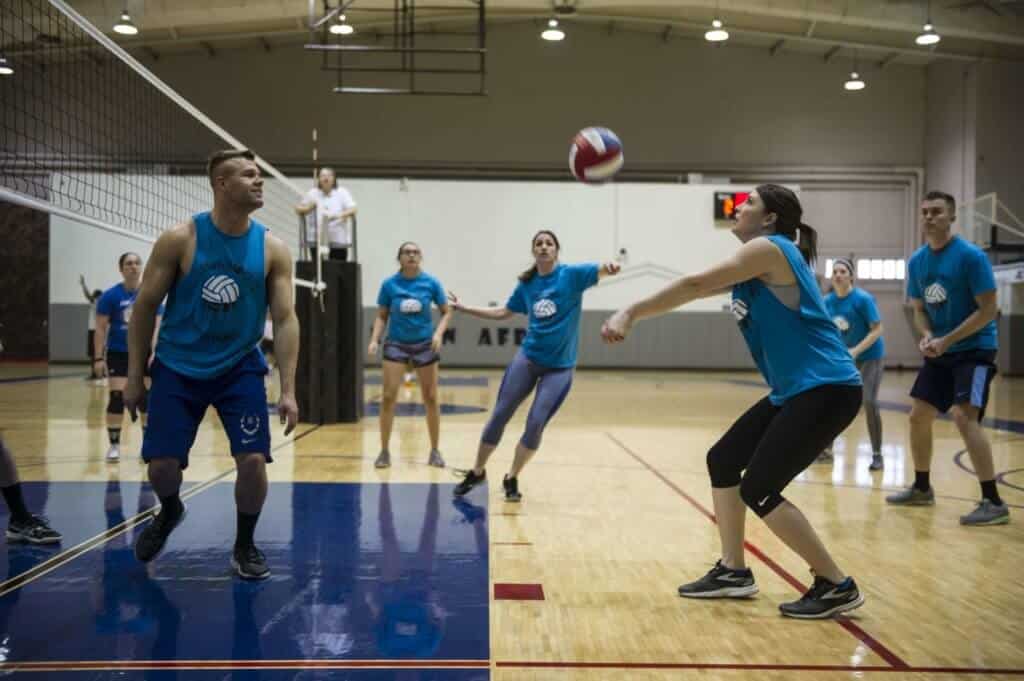
Now I have already let the cat out the bag on this drill as I have already discussed the drill in great detail above.
In case you didn’t read that section and don’t want to flick back through to find it I will rewrite it below.
3-2-1-0 Drill
The 3-2-1-0 drill is based on the passing scoring system nearly all teams use.
The 3,2,1,0 scoring system is a way of measuring how good or bad a pass was.
- 3 – Perfect Pass
- 2 – Good Pass
- 1 – Okay Pass
- 0 – Passing Error
Now you may be thinking how exactly you determine what is a perfect pass compared to a good pass.
Well the easiest way to think of this is how many options did the setter have.
For example if the pass is perfect they can set the middle, outside hitter or the opposite player. This means they had 3 hitting options
If the pass isn’t very good and the setter has to set the outside hitter they only have 1 setting option because of the pass.
Think of these numbers as how many options did the setter have available and they will become more obvious.
This is where we can use this scoring system to improve passing specifically during serve receive.
To set this drill up for players to practice free ball passing we will need 1 passer, three hitters and one setter on one half of the court with a feeder on the opposite side.
The feeder will throw a free ball over the net in the general direction of the receiver.
The passer will play the freeball and aim to give a perfect pass into the setter.
The setter as they are about to set the ball will call whether the pass was a 3, 2, 1 or 0.
The setter will then distribute the ball to one of the attackers of their choosing.
Now this drill can be done without the attackers however it might be a good opportunity to get some hitting reps in.
The idea of the drill is to allow the passer to visually see what a perfect pass looks like and what a shank looks like.
This drill is not to make the passer feel bad about their passing but to try and get a more consistent reception and make the setters’ life easier.
Game Situation Passing Drills
What better way to practice game situation passing then, well, playing games?
The best drill for this to keep the integrity of the session without turning it into a free for all scrimmage is to play attack vs defense.
Attack vs Defense
Attack vs Defense is a fantastic way to end a session on a fun note whilst allowing players to practice all the different types of passing.
To play attack vs defense you effectively want to set up as if you are about to have a scrimmage match however pick 1 team to serve the whole time.
The serving team will be in the lead by the 2 points and it is the job of the attackers to come back and win the game.
Generally when we play this we start the serving team on 17 with the attacking team on 15.
This drill forces the attackers to go for each attack with everything they have to try and come back and win the game which offers lots of opportunities to pass, dig and receive the ball to keep the rally going.
After the serve the rally is played out as normal however, the side that wins the rally will score the point but only the serving team will remain serving.
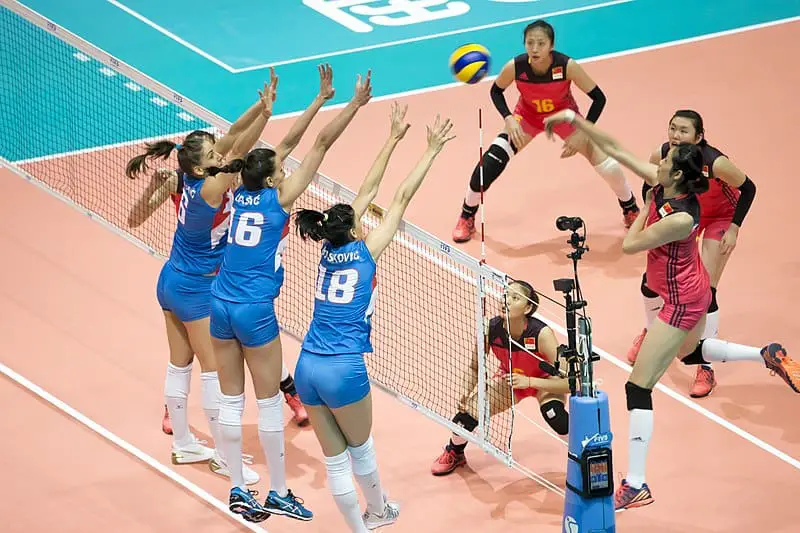
Hopefully this extensive list of advanced passing drills has given you some ideas for your next training session.
Implement a few of these drills and watch your team emerge as the defensive kings.
